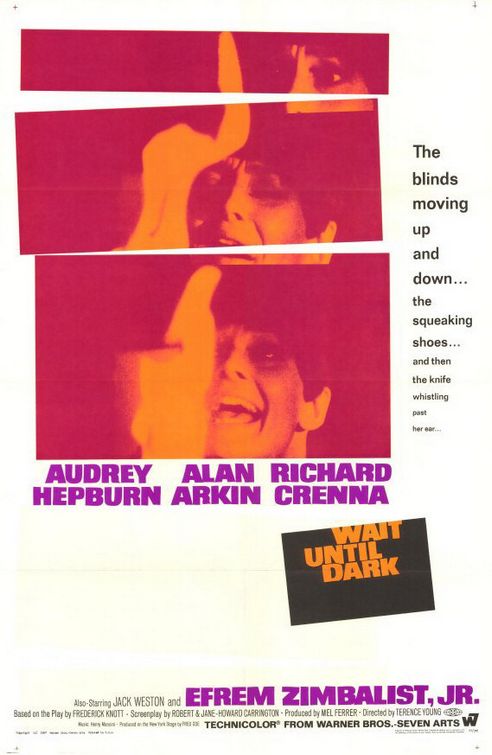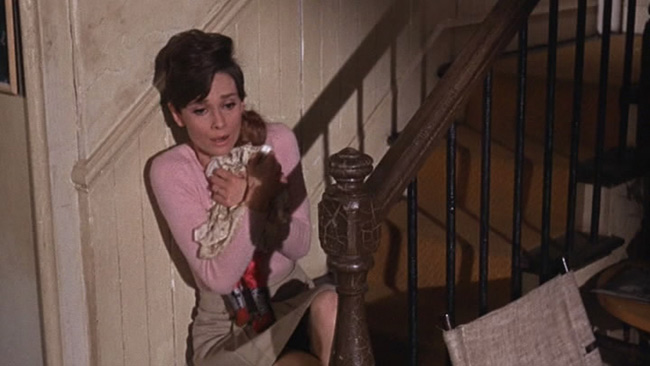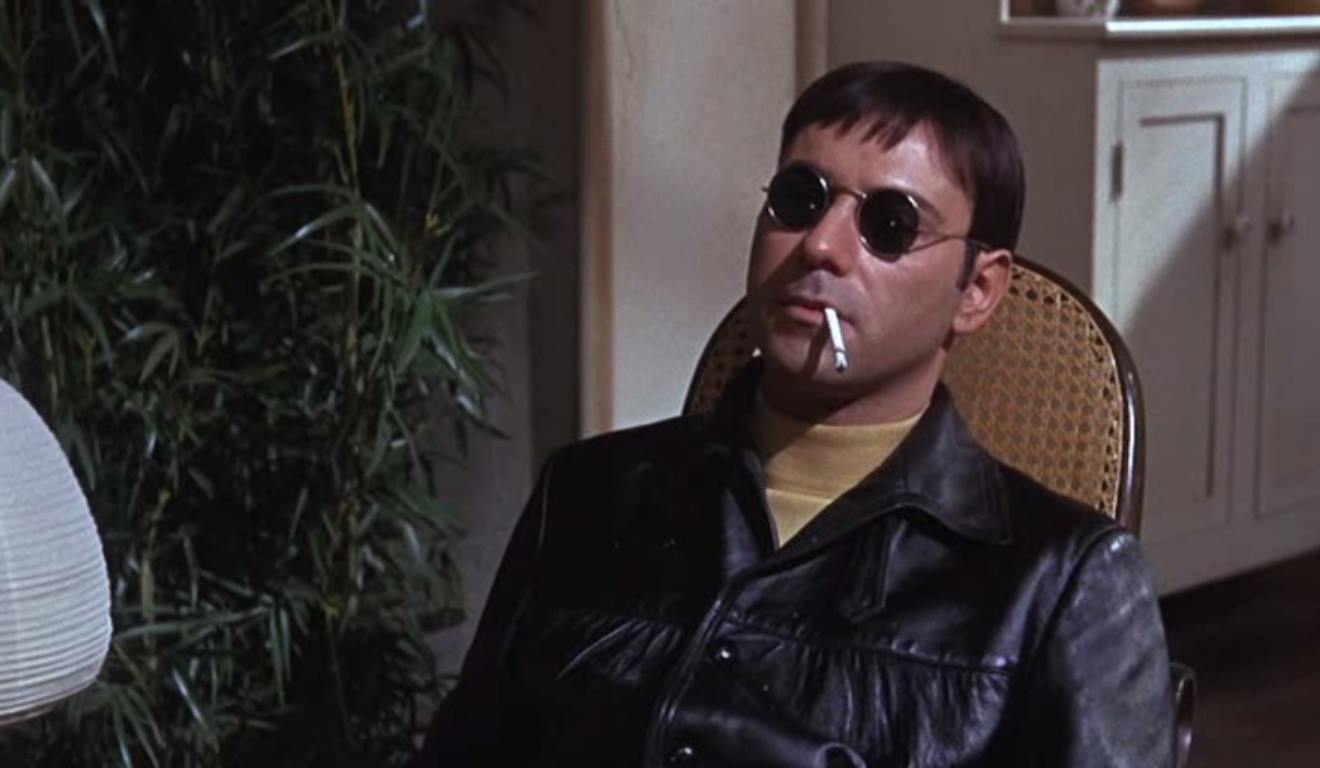50th Anniversary: Wait Until Dark
 Friday, October 27, 2017 at 11:19AM
Friday, October 27, 2017 at 11:19AM by Tim Brayton
 This week marks the 50th anniversary of Wait Until Dark. The grotty thriller was initially mostly sold on the basis of a third-act gimmick (the climax takes place in total darkness, and theaters were instructed to turn down all security lights and such things for the climax). And yet here we are, half a century later, and gimmick or not, the film holds up extraordinarily well. It's one of the best thrillers of its generation, with two of the best genre performances ever, one from brand-new screen actor Alan Arkin (it was just his second feature film role), the other from beloved screen icon Audrey Hepburn, functionally at the end of her career (she'd retire for nine years, and only made four more films over the next 22 years).
This week marks the 50th anniversary of Wait Until Dark. The grotty thriller was initially mostly sold on the basis of a third-act gimmick (the climax takes place in total darkness, and theaters were instructed to turn down all security lights and such things for the climax). And yet here we are, half a century later, and gimmick or not, the film holds up extraordinarily well. It's one of the best thrillers of its generation, with two of the best genre performances ever, one from brand-new screen actor Alan Arkin (it was just his second feature film role), the other from beloved screen icon Audrey Hepburn, functionally at the end of her career (she'd retire for nine years, and only made four more films over the next 22 years).
Quite a strange Audrey Hepburn vehicle it is, too...
After a career spent as one variety or another of inordinately gorgeous, classy European figures, capping things by playing a blind woman fending off heroin smugglers. Maybe it's because of that novelty that she gives such a remarkably strong performance, maybe it was some awareness that this was her last hurrah – maybe it was even something in the grubby script that inspired her, though I cannot imagine what – regardless, this is among the very strongest performances she ever gave, a tightly-focused piece of technical acting that makes Susy Hendrix a far more vivid, distinctive character than the ruthless clockwork plotting of the script (by Robert Carrington & Jane-Howard Carrington, from the play by Frederick Knott) would necessarily demand.
To be sure, there's nothing here like the depth of characterization found in Hepburn's work in something like The Nun's Story, or fellow 1967 release Two for the Road. This is ultimately a nasty little thriller, not a character story. Still, part of what makes it such a wonderful thriller is the full sense we get of Susy as a human being. There's some genuinely subtle writing in how the script presents her marriage to Efram Zimbalist, Jr's Sam. But of course the most impressive thing is the care with which she plays the physicality of a character unaccustomed to living without sight, in her heavily-researched, but thoroughly casual and organic movements. We can see the thought process behind every step, and gesture – Susy's thoughts, that is, not Hepburn's.

Meanwhile, her chief co-star is almost as good: Arkin's performance of the dangerous criminal Roat was a major early success in establishing his career, and for good reason. There's something fundamentally inhuman about his performance, and his whiny, hissing line deliveries, which feel like something stagey and campy turned rotten and sour. He is among the small population of movie psychopaths who feel genuinely, urgently threatening, thanks to how hard it is to ever imagine what might possibly be going on inside his head. His boredom and self-amusement both feel more uncomfortable than any more overtly menacing, loud performance might have done; there's a reptilian, alien quality to Arkin that really is like nothing else in any '60s thriller I can name.
Beyond its actors, Wait Until Dark is simply a very excellent piece of film craftsmanship. Director Terence Young, surely best known for helming three of the first four James Bond movies, doesn't have the effortless ability with the material of a natural born thriller-maker, like Alfred Hitchcock; some of the compositions, and particularly all of the business with the refrigerator near the end, certainly feel like they've been carefully worked out on paper and transferred to the screen. Still, when the tension is still burning low, Young and company do exemplary work in crafting a sense of tensely coiled unease that never quite erupts into full-on terror. Much of that certainly has something to do with Hepburn's performance, but there's also much to admire in how the filmmakers use the solitary apartment set that houses up nearly all of the onscreen action, enforcing a stuffy stillness onto the film that grows more and more suffocating as it goes along.

And even beyond that, the film derives a substantial quantity of horrible tension from the simplest source of all: Henry Mancini's ingenious, groundbreaking score. It's an early example of purely formalist technique used in film music: the main theme is performed by two pianos, tuned just slightly off from each other, so that as they played together it generated a dissonant, queasy tone. It was enough to make the pianists themselves feel unsettled and put off; it certainly works to instill a similarly repulsed feeling in the viewer. This is surely less of an obvious source of the film's power than Arkin's monstrous villain or Hepburn's impressive blend of weakness and fortitude, but it's so essential as to operate on an inescapable physiological level rather than an artistic one. Whatever the case, the film's exceptional skill at creating a sense of raw, weary tension is enough to leave it a singularly effective thriller decades after it would otherwise seem to have aged out of potency.



Reader Comments (7)
WUD is truly a favorite of mine. People screaming at the cinema from that shock in a crucial scene... that was really something. WUD is the crowning jewel of all damsel-in-distress films. Worthy predecessors were The Spiral Staircase, with Dorothy McGuire playing a mute hounded by a serial killer, and Experiment in Terror, in which Lee Remick is a bank clerk extorted by an asthmatic criminal she doesn't know to steal money from the bank. The scene where she goes into the dark garage and hears the wheezing sound of his asthma is nerve-wrecking.
Saw this again recently and it holds up so well. Hepburn is fantastic and the tension slowly building made for an incredible climax.
One interesting bit I forgot to mention. Lee Remick of Experiment in Terror generated the role of Susy in Wait Until Dark for the original Broadway run in 1966, and won a Tony for it! I guess the producers of the film thought Audrey Hepburn was a much better box-office draw!
Tim, terrific essay. This was one of my faves as a kid. I would always watch it whenever it popped up on TV. I recently saw it on the big screen, and it really still hits you hard. Hepburn, who deserved her Oscar nom, and Arkin are in top form. I read that this was his most difficult role because he had to be a bastard to Audrey Hepburn, and who would ever want to do that! That Mancini score--a classic. And there's something in the way that Roat cuts open that doll--it's so savage and upsetting. Yeah, this is one of the screen's memorable thrillers.
I saw the movie recently for the first time and was blown away with Hepburn's performance - what an amazing mix of vulnerability and strength. The only other example that comes to my mind is Farrow in Rosemary's Baby who should have been nominated that year over the other Hepburn.
And the movie itself aged great too. That final confrontation was fucking awesome - if thriller makes you literally jump and gasp, then it is a good one.
I wish Audrey Hepburn had won a second Oscar for this. I saw Lee Remick on stage and she was also excellent. Mancini's fine score was released not too long ago on CD for the first time.
Actually, Lee Remick was nominated for the Tony that year but lost to Rosemary Harris for “The Lion in Winter”.
“Wait Until Dark” is also a great favorite of mine. It is one of Audrey’s finest performances. I love the scene where she is running around smashing light bulbs. That one scene where she runs through the hallway smashing the light with her walking stick because she doesn’t really know where the light is - that showed how vulnerable Suzy was. I also love all of her scenes with Gloria.
A favorite memory of mine is showing this one night in college. At first the guys I lived with were like “WTF are we watching?”then get glued to the screen, and then jump out of their skins at the climax